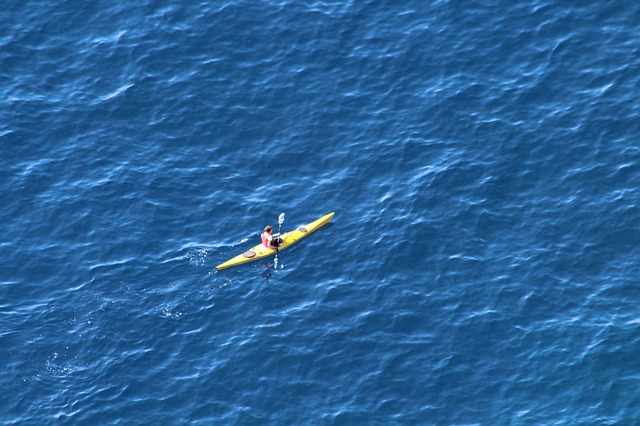When learning to kayak, knowing how to get in a kayak in deep water is an important skill. Whether you capsize or just wanted to cool off and take a swim, you’ll need to re-enter your kayak before you can continue your paddle. While this task can seem daunting at first, there are some simple steps to follow, and in today’s article I’ll talk you through what to do if you need to re-enter your kayak in deep water.
If your kayak capsizes, one of the most important things to remember is to stay calm. It’s easy to panic, but doing so will make these next tasks even more difficult for you.
You’ll expend energy more quickly and panicking will make it harder for you to think clearly. Make sure you wear personal flotation equipment while kayaking, since that will also help you get back into the kayak by providing extra buoyancy and ease of mobility. It’s also the law to wear a life jacket in most states.
I recommend that one of the first things you do when you start kayaking is to practice your wet exit in calm waters near shore. You need to get comfortable exiting your kayak while submerged so you don’t panic if (when) it happens in deep water.
Types of Kayaks
The methods for getting back into your kayak will differ depending on whether you have a sit-inside or sit-on-top kayak. There are unique challenges to get in a kayak in deep water with each type.

Sit-inside kayaks are more stable because you can use your knees to control the hull, meaning capsizing is less likely. Even though your legs are enclosed within the kayak, you can still get out of the kayak easily. The issue with a sit-in kayak capsizing is that your kayak will fill with water once flipped.
If you’re using a sit-on-top kayak, you can fall freely into the water since your legs are not enclosed. These crafts will still fill with some water, but less-so than the sit-inside variety. Their design is for recreational use, which means they are designed to be more stable. Their design features tend to make them more difficult to flip over while paddling. Since there is no enclosure around your legs, it’s particularly safe for beginners.
Flipping your Kayak in Deep Water
The first step is flipping your kayak back over. Here are the three steps you’ll want to take to flip your kayak in deep water:
- Position yourself at the center of the kayak where the seat is.
- Reach across the back of the kayak and grab the opposite edge with both hands.
- Use your weight and pull it towards you. You can also brace your legs against it for extra propulsion. It’s important to do this promptly, since the longer it stays in the water, the more water can fill the hull and compartments.
Techniques to Get in a Kayak in Deep Water
After getting your kayak right-side up, make sure to grab any loose equipment and secure it to your kayak. This is a lot easier if you have a leash for your paddle (they’re about $10 on Amazon – get one) but securing it to the kayak’s bungee cords or other equipment can work too.
If you have any containers that float, you can use them to propel yourself upwards. If you have a cooler, for instance, you can put your foot in the handle for extra flotation.
To get in a kayak in deep water, grab the handles on either side of the kayak seat first. Then kick your legs up to the water’s surface to propel yourself up across the kayak. You want your belly button to be in the seat while facing down towards the water. Once you’re secure, brace your arms and spin your body around so your butt is back in the seat. If you’re in a sit-inside kayak, you’ll then also put your feet back into the kayak and start paddling again.
If you’re in a sit-inside kayak, then brace your arms against the sides and handrails to pull your feet into the kayak and get back into your seat. Since sit-inside kayaks fill easily with water, you’ll have to pull it back onto the shore and dump the remaining water out before you can continue on an extended ride. Alternatively, you can use a bilge pump to get the water out or try to bail it out.

If you’re in a tandem kayak, you’ll have to take turns with your partner getting back into the kayak while the other holds the kayak steady. If you go kayaking with children, it’s imperative to teach them safe water re-entry. Teach them on still water and play act with them that the waters are rougher than they are. Use their imagination and rock the boat to let them learn the method. Help them understand they may need to swim to shore and to look out for others. Go through a procedure as a group to get everyone safely back into their kayaks.
Re-Entering a Kayak Isn’t as Tough as it Seems
Knowing the safest way to get back in a kayak in deep water will give you the confidence to go out on the water and be safe about it. One of the biggest difficulties with getting back into your kayak is the condition of the water you’re in. Getting back into the kayak is easier and more straightforward in calm waters. However, if you capsize in rough ocean waters or in some white water, then you’ll have a far more difficult time.
Wearing flotation equipment is even more important in those scenarios.
Falling out of a kayak is scary, which is why it’s so important to be prepared and know what to do in that situation. It’s a lot easier said than done, but staying calm in this situation is especially important.
Keeping calm will help you save energy you can use to get back into your kayak quickly and safely.

